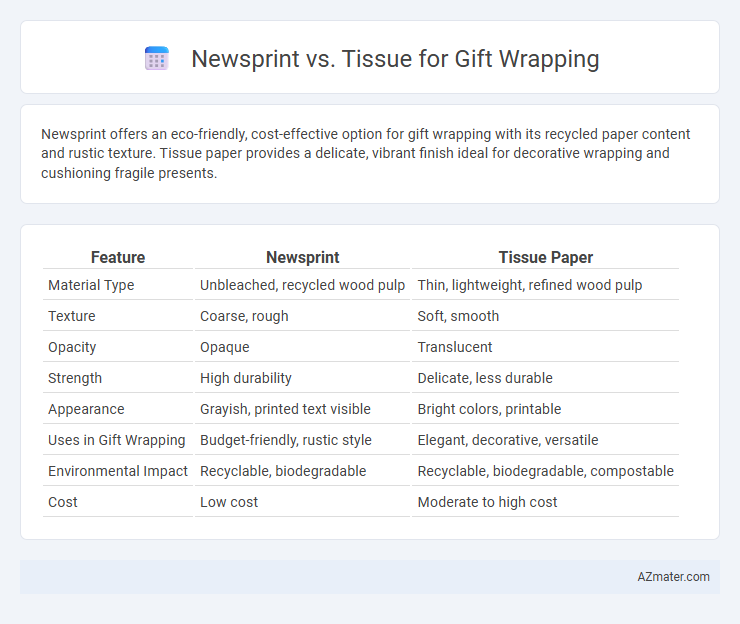Newsprint offers an eco-friendly, cost-effective option for gift wrapping with its recycled paper content and rustic texture. Tissue paper provides a delicate, vibrant finish ideal for decorative wrapping and cushioning fragile presents.
Table of Comparison
| Feature | Newsprint | Tissue Paper |
|---|---|---|
| Material Type | Unbleached, recycled wood pulp | Thin, lightweight, refined wood pulp |
| Texture | Coarse, rough | Soft, smooth |
| Opacity | Opaque | Translucent |
| Strength | High durability | Delicate, less durable |
| Appearance | Grayish, printed text visible | Bright colors, printable |
| Uses in Gift Wrapping | Budget-friendly, rustic style | Elegant, decorative, versatile |
| Environmental Impact | Recyclable, biodegradable | Recyclable, biodegradable, compostable |
| Cost | Low cost | Moderate to high cost |
Introduction: The Gift Wrapping Dilemma
Newsprint offers an economical and eco-friendly option for gift wrapping, made from recycled paper with high printability but a rougher texture. Tissue paper provides vibrant colors, softness, and delicate translucency, enhancing gift presentation and experience. Choosing between newsprint and tissue depends on budget, aesthetic preference, and environmental considerations.
What Is Newsprint?
Newsprint is a low-cost, uncoated paper primarily made from wood pulp, widely used in newspaper printing due to its lightweight and absorbent properties. Its slightly rough texture and natural grayish or off-white color provide a rustic, vintage aesthetic that appeals to eco-conscious consumers for gift wrapping. Unlike tissue paper, newsprint offers greater durability and opacity, making it ideal for protecting delicate items while adding an artistic, recycled look to wrapping projects.
What Is Tissue Paper?
Tissue paper is a thin, lightweight, and translucent paper primarily made from recycled pulp or wood fibers, designed for delicate uses such as wrapping gifts or cushioning fragile items. Unlike newsprint, which is denser and rougher, tissue paper offers a soft texture and is often available in various colors and patterns, enhancing the aesthetic appeal of gift wrapping. Its gentle composition reduces the risk of tearing or damaging precious presents while providing a refined, decorative finish.
Eco-Friendliness: Which Is Greener?
Newsprint and tissue paper both serve as popular gift wrapping options, but their environmental impacts differ significantly. Newsprint, often recycled and biodegradable, reduces waste by repurposing old newspapers, making it a sustainable choice for eco-conscious consumers. In contrast, tissue paper, particularly when produced from virgin fibers and featuring dyes or coatings, tends to have a higher carbon footprint and limited recyclability, positioning newsprint as the greener alternative for gift wrapping.
Cost Comparison: Newsprint vs Tissue
Newsprint offers a significantly lower cost per square foot compared to tissue paper, making it an economical choice for large-scale gift wrapping projects. While tissue paper provides a smoother, more decorative finish, its higher price point can impact budget considerations for businesses and individuals seeking affordable wrapping solutions. Newsprint's cost-effectiveness is primarily due to its widespread availability and lower production expenses, positioning it as the preferred option for cost-conscious consumers.
Visual Appeal and Presentation
Newsprint offers a rustic, vintage aesthetic with its muted gray tones and printed text, making it ideal for eco-conscious gift wrapping that emphasizes a minimalist, artistic presentation. Tissue paper enhances visual appeal with vibrant colors and delicate translucency, adding softness and elegance that elevate the overall gifting experience. Choosing between these materials depends on the desired presentation style--newsprint for a unique, understated look or tissue for a bright, festive finish.
Durability and Protection
Newsprint offers superior durability and tear resistance compared to tissue, making it ideal for wrapping heavier or irregularly shaped gifts. Its thicker, denser fibers provide enhanced protection against damage during handling and transport. Tissue paper, while softer and more delicate, excels in providing a decorative touch but may require additional layers to ensure adequate protection.
Ease of Use and Versatility
Newsprint offers exceptional ease of use for gift wrapping due to its lightweight and flexible texture, allowing quick and precise folding without tearing. Tissue paper provides superior versatility with its variety of colors, patterns, and translucency options, enhancing aesthetic appeal for different gift sizes and styles. Both materials cater to different wrapping needs, with newsprint excelling in durability and practicality, while tissue paper shines in decorative customization.
Creative Gift Wrapping Ideas
Newsprint offers a rustic, eco-friendly texture that enhances creative gift wrapping ideas by providing a vintage aesthetic and a customizable canvas for stamps, drawings, or calligraphy. Tissue paper, available in a wide array of colors and patterns, adds softness and elegance to wrapped gifts, allowing for layered designs and delicate finishes like ruffles or bows. Combining newsprint with tissue creates contrast and depth, perfect for unique, sustainable gift presentations that stand out with artistic flair.
Conclusion: Choosing the Best Wrapping Material
Newsprint offers a budget-friendly and eco-conscious option for gift wrapping, ideal for a rustic or vintage aesthetic, while tissue paper provides vibrant colors and delicate textures that enhance visual appeal. The choice depends on the occasion, desired presentation, and environmental considerations, with newsprint excelling in sustainability and tissue paper favored for its decorative versatility. Selecting the best wrapping material balances cost, style, and eco-impact to align with personal or brand values.

Infographic: Newsprint vs Tissue for Gift Wrapping
 azmater.com
azmater.com